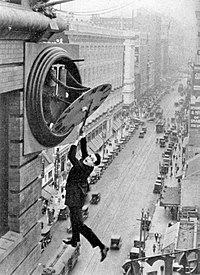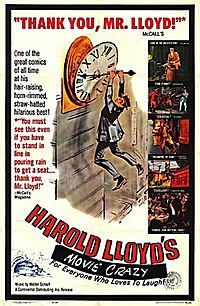Radio and retirement[edit]
In October 1944, Lloyd emerged as the director and host of The Old Gold Comedy Theater, an NBC radio anthology series, after Preston Sturges, who had turned the job down, recommended him for it. The show presented half-hour radio adaptations of recently successful film comedies, beginning with Palm Beach Story with Claudette Colbert and Robert Young.
Some saw The Old Gold Comedy Theater as being a lighter version of Lux Radio Theater, and it featured some of the best-known film and radio personalities of the day, including Fred Allen, June Allyson, Lucille Ball, Ralph Bellamy, Linda Darnell, Susan Hayward,Herbert Marshall, Dick Powell, Edward G. Robinson, Jane Wyman, and Alan Young. But the show's half-hour format—which meant the material might have been truncated too severely—and Lloyd's sounding somewhat ill at ease on the air for much of the season (though he spent weeks training himself to speak on radio prior to the show's premiere, and seemed more relaxed toward the end of the series run) may have worked against it.
The Old Gold Comedy Theater ended in June 1945 with an adaptation of Tom, Dick and Harry, featuring June Allyson and Reginald Gardiner and was not renewed for the following season. Many years later, acetate discs of 29 of the shows were discovered in Lloyd's home, and they now circulate among old-time radio collectors.
Lloyd remained involved in a number of other interests, including civic and charity work. Inspired by having overcome his own serious injuries and burns, he was very active as a Freemason and Shriner with the Shriners Hospital for Crippled Children. He was a Past Potentate of Al-Malaikah Shrine in Los Angeles, and was eventually selected as Imperial Potentate of the Shriners of North America for the year 1949–50.[24] At the installation ceremony for this position on July 25, 1949, 90,000 people were present at Soldier Field, including then sitting U.S. President Harry S Truman, also a 33° Master Mason.[25] In recognition of his services to the nation and Freemasonry, Bro. Lloyd was invested with the Rank and Decoration of Knight Commander Court of Honour in 1955 and coroneted an Inspector General Honorary, 33°, in 1965.
He appeared as himself on several television shows during his retirement, first on Ed Sullivan's variety show Toast of the Town June 5, 1949, and again on July 6, 1958. He appeared as the Mystery Guest on What's My Line? on April 26, 1953, and twice on This Is Your Life: on March 10, 1954 for Mack Sennett, and again on December 14, 1955, on his own episode. During both appearances, Lloyd's hand injury can clearly be seen.[26]
Lloyd studied colors, microscopy, and was very involved with photography, including 3D photography and color film experiments. Some of the earliest 2-color Technicolor tests were shot at his Beverly Hills home (These are included as extra material in the Harold Lloyd Comedy Collection DVD Box Set). He became known for his nude photographs of models, such as Bettie Page and stripper Dixie Evans, for a number of men's magazines. He also took photos ofMarilyn Monroe lounging at his pool in a bathing suit, which were published after her death. In 2004, his granddaughter Suzanne produced a book of selections from his photographs, Harold Lloyd's Hollywood Nudes in 3D! (ISBN 1-57912-394-5).
Lloyd also provided encouragement and support for a number of younger actors, such as Debbie Reynolds, Robert Wagner, and particularly Jack Lemmon, whom Harold declared as his own choice to play him in a movie of his life and work.
Renewed interest[edit]
Lloyd kept copyright control of most of his films and re-released them infrequently after his retirement. Lloyd did not grant cinematic release because most theaters could not accommodate an organist, and Lloyd did not wish his work to be accompanied by a pianist: "I just don't like pictures played with pianos. We never intended them to be played with pianos". Similarly, his features were never shown on television as Lloyd's price was high: "I want $300,000 per picture for two showings. That's a high price, but if I don't get it, I'm not going to show it. They've come close to it, but they haven't come all the way up". As a consequence, his reputation and public recognition suffered in comparison with Chaplin and Keaton, whose work has generally been more available. Lloyd's film character was so intimately associated with the 1920s era that attempts at revivals in 1940s and 1950s were poorly received, when audiences viewed the 1920s (and silent film in particular) as old-fashioned.
In the early 1960s, Lloyd produced two compilation films, featuring scenes from his old comedies, Harold Lloyd's World of Comedy and The Funny Side of Life. The first film was premiered at the 1962 Cannes Film Festival, where Lloyd was fêted as a major rediscovery. The renewed interest in Lloyd helped restore his status among film historians. Throughout his later years he screened his films for audiences at special charity and educational events, to great acclaim, and found a particularly receptive audience among college audiences: "Their whole response was tremendous because they didn't miss a gag; anything that was even a little subtle, they got it right away".
Following his death, and after extensive negotiations, most of his feature films were leased to Time-Life Films in 1974. As Tom Dardis confirms: "Time-Life prepared horrendously edited musical-sound-track versions of the silent films, which are intended to be shown on TV at sound speed [24 frames per second], and which represent everything that Harold feared would happen to his best films".
An acclaimed 1990 documentary, Harold Lloyd: The Third Genius by Brownlow and Gill, which was shown as part of the PBS series American Masters, created a renewed interest in Lloyd's work but the films were largely unavailable. In 2002, the Harold Lloyd Trust re-launched Harold Lloyd with the publication of the book Harold Lloyd: Master Comedian by Jeffrey Vance and Suzanne Lloyd[27][28] and a series of feature films and short subjects called “The Harold Lloyd Classic Comedies” produced by Jeffrey Vance and executive produced by Suzanne Lloyd for Harold Lloyd Entertainment. The new cable television and home video versions of Lloyd's great silent features and many shorts were remastered with new orchestral scores by Robert Israel. These versions are frequently shown on the Turner Classic Movies (TCM) cable channel. A DVD collection of these restored or remastered versions of his feature films and important short subjects was released by New Line Cinema in partnership with the Harold Lloyd Trust in 2005, along with theatrical screenings in the US, Canada, and Europe. Criterion Collection has subsequently acquired the home video rights to the Lloyd library, and have released Safety Last![29] and The Freshman.[30]
In the June 2006 Los Angeles Chamber Orchestra Silent Film Gala program book for Safety Last!, film historian Jeffrey Vance stated that Robert A. Golden, Lloyd's assistant director, routinely doubled for Harold Lloyd between 1921 and 1927. According to Vance, Golden doubled Lloyd in the bit with Harold shimmy shaking off the building's ledge after a mouse crawls up his trousers.[31]
Academy Award[edit]
In 1953, Lloyd received an Academy Honorary Award for being a "master comedian and good citizen". The second citation was a snub to Chaplin, who at that point had fallen foul of McCarthyism and who had had his entry visa to the United States revoked. Regardless of the political overtones, Lloyd accepted the award in good spirit.
Death[edit]
Lloyd died at age 77 from prostate cancer on March 8, 1971, in Beverly Hills, California.[13][32][33] He was interred in a crypt in the Great Mausoleum at Forest Lawn Memorial Park Cemetery in Glendale, California.[34]




No comments:
Post a Comment